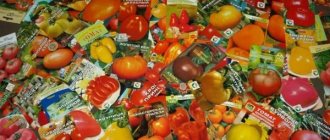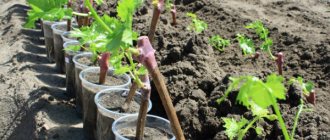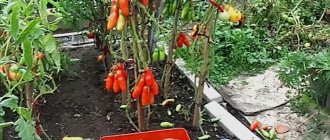Pros and cons of growing indoor tomatoes on a window
Is it possible to harvest tomatoes at home? At this stage of development of selection, many varieties have been developed that are suitable for growing at home in winter. Even a novice agronomist will be able to grow a good crop of tomatoes on his windowsill.
The advantage of such cultivation is to obtain healthy tomatoes in winter. An agronomist can also be confident that his harvest will be environmentally friendly. The taste of tomatoes will be almost the same as that of a summer harvest from open ground.
It is also worth saying that the cost of tomatoes from the windowsill will be much less than those purchased in the store.
The disadvantage of planting tomatoes in an apartment is the fact that it is not always possible to grow tomatoes. And sometimes the fruits may be too small in size , which is why such cultivation may be impractical.
Suitable soil
To grow tomatoes in an apartment on a windowsill in winter, choose fertile soil with a good ability to absorb moisture and allow air to pass through. A mixture of forest soil and high-quality compost, taken in equal volumes, is suitable. But a more complex composition is also allowed:
- 2 parts humus;
- 2 parts peat;
- 1 part sand.
When you don’t want to bother with mixing the soil yourself, use a store-bought version of the soil for germinating nightshade seedlings.
Important!
Before sowing, any soil is subjected to heat treatment to disinfect and destroy harmful microbes and fungi. It is calcined in the oven or treated with hot steam. For the same purpose, use a solution of the drug “Fitosporin” or potassium permanganate.
Preparation activities
What should the place be like?
Tomatoes are light-loving crops. Therefore, it is best to give preference to the southern sides of the room. If it is not possible to place tomatoes in the southern part, then you should take care of additional lighting. Remember that daylight hours for tomatoes should last at least 12-13 hours. Fluorescent lamps, fluorescent lamps, and energy-saving lamps can be used as artificial light. Now there are special phytolamps. Additional lighting should be placed at a height of 25-30 centimeters from the plants.
As for the air temperature, it should remain at 22-24 degrees Celsius. At night the temperature can be reduced to +16-18 degrees. If the air is heated less, the tomatoes will not grow. And in strong hot air, the crop will begin to dry out. If the room is very hot, you should ventilate the room more often, being careful not to create drafts.
Make sure that the air in the room is sufficiently humidified. You should not place containers with tomatoes close to heating devices, because they dry out the air and the plant itself. It is best to place a container of water next to the tomatoes, which will serve as a homemade humidifier.
Special varieties for winter
To get a good harvest, you must first choose the right variety for planting. Since not every variety is suitable for growing at home. Choose low or medium height bushes. It’s good if these are cherry tomatoes, since this type can easily survive a lack of light and heat, and it also has a shorter ripening period. There are many varieties intended for growing at home. Among the most popular are the following:
- Pearl.
- Balcony miracle.
- Hummingbird.
- The pearl is yellow.
- Pinocchio.
- Angelica.
- Glasha.
- Alpatyeva 905 A.
- Moskvich.
What should the pot be like?
In order to grow seedlings for winter cultivation at the initial stage, ordinary plastic cups in which you need to make drainage holes are also suitable. But special peat cups are more suitable. As soon as the seedlings are ready for picking, they need to be moved into pots with a volume of 7-10 liters. The material of the flowerpot is not particularly important. Plastic, clay, and ceramics are also suitable.
Soil features
The soil can be purchased ready-made in the store, or you can prepare it yourself. To do this, we take soil, humus, coarse river sand and peat. The components are taken in the following proportions: 5:5:2:1.
For every 10 liters of substrate you need to add a little urea (no more than a matchbox). You need to take potassium sulfate in the same amount, as well as a tablespoon of wood ash. All ingredients are thoroughly mixed and scattered into containers.
Video
You can also watch a video where they will show you how to build a greenhouse where you can grow vegetables in winter.
Many gardeners are thinking about setting up winter greenhouses, as this allows them to obtain fresh, healthy products all year round. Of course, you will have to devote more time to caring for the tomatoes, but the result will be excellent and there will be fresh, aromatic tomatoes on the table even in winter.
There are a lot of tomato varieties on the market, with low requirements for lighting and temperature conditions, so choosing the ones you need won’t be difficult.
Step-by-step instructions for planting on a windowsill
Seeds
Reference! Before sowing, it is better to soak the seeds in a growth stimulator. Otherwise, there is a risk that the seeds will not germinate.
- The substrate is poured into the planting container, and then a seed is placed there, which is sprinkled with a small (about 10 mm) layer of soil.
Moisten the soil with a spray bottle so that the seeds are not washed out. Water for irrigation should be left standing for at least 2-3 days.- After planting, the cups are placed in a bright and warm place.
The cups can be covered with film until the first shoots. - Within 7 days the first shoots will appear. They need to be opened every day for hardening, and after 3-4 days the film must be removed completely.
- Grown seedlings need to be watered once every 4-5 days.
The seedlings do not need spraying. You can pick out sprouts only when at least 4 leaves appear on them.
Seedlings
Before this procedure, you need to prepare containers. For this:
- A drainage layer is placed in the flowerpots. It can be made from brick chips or small gravel. The pot is completely filled with substrate. In the middle of the flowerpot you need to make a small depression, which is thoroughly moistened.
- The seedlings are watered from the roots and moved into prepared flowerpots.
Water again. The soil is slightly compacted. Important! Experienced agronomists do not recommend planting two sprouts in one flowerpot. They will not produce a good harvest or will die altogether. - The pots are placed in a well-lit place. The containers are turned twice during the day so that the plant develops evenly.
Growing tomatoes in a greenhouse
In order for tomatoes to delight you with a rich and healthy harvest, you should take care of the premises in advance and choose the right variety. Summer temporary structures and traditional garden varieties are unsuitable for the cold season.
Preparing the greenhouse for winter use
To grow tomatoes in winter, permanent buildings are built and equipped with a powerful heating system. Greenhouses are installed on a durable metal frame with anti-corrosion coating. Walls and roofs are made of glass or polycarbonate.
Attention ! Polycarbonate will reduce heating costs. It will create a thermos-like atmosphere inside the room. If a summer resident wants to grow a winter crop of tomatoes, he will need several heating devices.
The dimensions of a regular greenhouse are 100–500 m2, while an industrial greenhouse is about 1,000 m2. Tomatoes need a tall, wind-protected structure.
Choosing the right variety
To select the desired variety, its characteristics are determined:
- productivity - plants with high productivity significantly increase income;
- growing season - the faster the fruits ripen, the more profitable the business;
- disease resistance - a good variety is not susceptible to fungal and infectious diseases and does not require regular treatment with chemicals;
- taste - the fruits have a sweetish fleshy pulp with a pronounced aroma;
- size and color - buyers choose medium-sized vegetables in rich red, pink or yellow colors;
- resistance to damage - manufacturers indicate on the packaging information about the shelf life of tomatoes and their tolerance to transportation.
The most popular varieties:
- early and mid-ripening - Podarok, Aksinya, Cherry, Evpator, Kostroma, Palenka;
- hybrids with a short growing season - Verlioka, Rhapsody, Caspar, Sprinter, Etude, Farmer;
- varieties with a pronounced taste - Honey Spas, Pink Honey, Orange King, Asteroid, Lady, Ballerina.
Reference . Vegetable growers place 2-3 different varieties in one greenhouse for reliability. Growing tomatoes is not an experiment, but an achievement of high yields.
How to care at home in winter: step-by-step instructions
Watering and fertilizers
The size of the fruit and its taste depend on the correct soil moisture regime. The soil must be constantly moist. It is important not to allow the substrate to dry out completely , as this may cause the tomatoes to drop. However, it is worth remembering that excess moisture can lead to rotting of the root system.
Since there is not enough space in the pots for the root system to fully develop, the roots need to be fed to grow. The first fertilizing should be done seven days after picking the seedlings. Most often, agronomists use the following drugs: Mortar, Nitrofaska and Aquarin. Fertilizers are applied three times a day, because there is nowhere for mineral elements to come from.
Starting from the third feeding, the concentration of fertilizers is slightly increased.
Trimming and pinching
Tomatoes need to be pinched starting from the growing season. As soon as the first fruits begin to set on the tomatoes, you need to remove the top of the tomato two leaves above the last bunch. This should only be done with a well-sharpened and disinfected instrument.
Experienced vegetable growers recommend leaving no more than two stepsons at the root - all the rest should be gotten rid of, since they will take away all the nutrients.
The most suitable place for these procedures is early morning or evening after sunset. The cut areas must be treated with ash or ash. With proper manipulation, tomatoes will give a rich harvest.
We are waiting for the harvest
During flowering, our tomatoes can occasionally be slightly shaken and a gentle feather brushed over the flowers - this will improve the pollination process.
After fruit set, the top of the stem and inflorescence should be removed to help the fruit form more quickly.
- To protect young tomatoes from late blight (this fungal disease threatens tomatoes even in winter), tomato leaves and stems must be periodically treated with an infusion of manganese and garlic (3 liters of water, ½ g of potassium permanganate and half a head of garlic).
Experienced gardeners also use another technique to more quickly form tomato fruits on the windowsill.
It’s called “pulling the roots”: take the tomato by the lower area of the stem and very carefully pull it up, as if you want to pull the plant out of the ground.
During this movement, small roots break off. After the procedure, the plant should be watered and hilled.
- During the flowering of tomatoes, experienced gardeners advise additional spraying of the second and third tassels of plants so that the fruits are better formed and set. Spray the tomatoes with a solution of boric acid (dilute a gram of the substance in a liter of water).
When our tomatoes are already ripening, the branches of the plant should be tied to pegs. Otherwise, the stems may break under the weight of the fruit.
It is advisable not to wait for the tomatoes on the bushes to fully ripen, but to harvest them when they are brown.
In room conditions, tomatoes will ripen quickly, and on bushes the next crop will ripen better and faster.
Support and hanging
Often, low-growing varieties are used for home cultivation. Such a bush can bear up to two kg of fruit. Therefore, there is no need for supports. But this procedure is necessary because most often it is the pots with soil that may not support the weight of the fruit and tip over.
- First you need to choose a suitable place to place the flowerpot. It is good if the flowerpot stands near some wall or window on which the entire bush will rest.
- Then you need to place wooden pegs in the pots (one support for each bush).
- A bush is tied to a peg - this needs to be done as high as possible.
Variety selection
When choosing a tomato variety to grow on a windowsill in winter, it is preferable to use low-growing varieties with a high growth rate and good yield, since apartment space is limited. Such plants do not take up significant space and after a short time they delight with a wealth of tasty fruits. The most popular varieties to grow at home in winter are:
- The balcony miracle forms a compact bush no more than 0.6 m tall. The tomatoes are small, round, with bright red flesh and ripen 3 months after sowing. One plant brings up to 2 kg.
- The non-hybrid variety Dubok forms a bush 0.4-0.6 m tall. It ripens early, forming round fruits with a fleshy interior. The bushes need to be pollinated artificially, but their advantage is insensitivity to late blight.
- The low-growing variety Ruby Red was created specifically for home growing. It forms small bushes up to half a meter in height. Small tomatoes are bright red in color and have a mild taste.
- White filling tomato bushes stretch up to 70 cm. The ripening period for round fruits weighing up to 130 g is 85 days. Fruits with red flesh have a pleasant taste with a slight sourness.
Diseases and pests, ways to combat them
The most common ailments are:
- Late blight. In this case, brown spots appear on the tomatoes, which increase over time. You can fight it with garlic tincture. Spraying is carried out several times with an interval of 5 days.
- Fusarium wilt. Characterized by wilting and yellowing of the lower leaf blades. Over time, other leaves begin to turn yellow. To get rid of this disease, you need to treat the plant with Barrier or Hom. After this, it is important to loosen the soil as often as possible.
- Alternaria blight. It is distinguished by small gray spots that look depressed. They fight this disease with the help of drugs such as Antrakol, Consento, Tattu.
Let's name tomato pests.
- Whitefly. This insect causes yellowing of the leaves, which soon turns black. You need to fight whiteflies with the drug Confidor.
- Slugs. They eat leaves and fruits. Affected plants begin to rot. To prevent slugs, you need to treat the soil with a solution of ash, tobacco dust or lime.
- Spider mite. It appears on tomatoes in the form of small dots. Sucks the juice out of the plant, which leads to death. A tincture of garlic or dandelions will help. You can add laundry soap to the solution.
- Medvedka. A rather large insect, the length of which reaches 5 centimeters. It affects the main root system of the plant. The fight is carried out using tincture of hot pepper or vinegar.
It is quite possible to grow tomatoes in an apartment in winter. And this is not difficult. Therefore, if you want to have home-grown tomatoes in winter, you need to put in a little effort and devote time to it. The main thing is just to wish.











